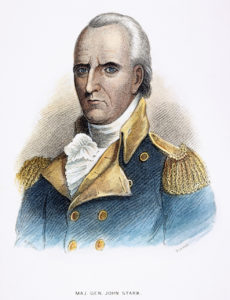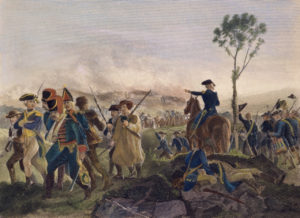Threads of History
John Stark, The Hero of Bennington
“Live Free or Die”
By John Krueger, Chair of the LCBP Heritage Area Program Advisory Committee

John Stark. 19th century American engraving. Granger Historical Picture Archive.
George Washington excepted, no one contributed as much to the British victory in the French and Indian War and to the American victory in the War for Independence as the New Hampshire frontiersman John Stark. Stark survived Indian captivity and fought alongside the British in the French and Indian War as a captain in Rogers’ Rangers. Still later in the War for Independence he fought against the British as a general. His greatest achievement took place at what became known as the Battle of Bennington, when on August 16, 1777, twelve days shy of his forty-ninth birthday, he led farmers and tradesmen to an improbable victory against professional European soldiers. It was the beginning of the end for the British invasion from Canada, until that moment an unstoppable juggernaut.
John Stark was born at Londonderry, New Hampshire, on August 28, 1728. When he was eight, his family moved to Derryfield (now Manchester), where they farmed on the frontier. Captured by a band of Abenaki warriors while on a hunting trip in the spring of 1752, Stark earned their respect by fighting his way through their gauntlet. The chief was so impressed by the young captive’s heroism that he was adopted by the tribe and remained with them until ransomed.”[1]
When Robert Rogers was ordered to form a corps of rangers in 1755, one of the first men he selected was his neighbor and good friend John Stark, who fought in many of the legendary battles and skirmishes along Lake George and Lake Champlain. As a lieutenant Stark saw action at the Battle of Lake George in September 1755. Promoted to captain, he served bravely at Ticonderoga in the Abercromby fiasco in 1758, and subsequently with General Amherst in 1759 as the builder of half of the Crown Point Road connecting Lake Champlain with the Connecticut River.[2]
Eight days shy of his thirtieth birthday, John married twenty-one-year-old Elizabeth Page on August 20, 1758. John called his bride Molly Stark for the rest of their life together. They had eleven children: five boys, five girls, and one daughter who died as an infant. At the conclusion of his service in the French and Indian War, John returned to Derryfield with Molly and directed his attention to his growing family, to the cultivation of his farm and to the care his mills.[3] He was of medium height, thin and erect, with light blue eyes and a cold, piercing stare.[4]
When news of Lexington and Concord reached him, John Stark organized his New Hampshire neighbors and led some 2,000 of them to Boston. Stark and his men held the left of the American line at the Battle of Breed’s Hill on June 17, 1775, stopping the British from turning the flank of the main American redoubt on top of the hill. After the last of the brave defenders in the redoubt were finally overrun, Stark and his soldiers put up a running fight as they fell back in good order and carried off their wounded, an action witnessed and admired by British General John Burgoyne, who commented it was “no flight, it was even covered with bravery and military skill.”[5]
Stark helped arrange the defenses of New York City. In the spring of 1776, he arrived in Canada just in time to join the retreat and then commanded a brigade that cleared and fortified Mount Independence. Stark crossed the Delaware River with Washington and commanded the right wing of the advance guard at the Battle of Trenton.
John Stark was a proud man, as hard as the granite of his beloved New Hampshire. Despite his obvious attainments and the high opinion of him held by officers and men alike, when new brigadiers were appointed by the Continental Congress in February 1777, Stark’s name was not on the list. He declared that an officer who would not stand up for his own rights ought not to stand for the rights of his country. Stark felt it was improper for him to hold a commission in the Continental Army. In March he retired to his farm and family in Derryfield.[6]
The dramatic year 1777 overshadows the rest of the War for Independence in the Champlain Valley. On May sixth, the first ship of the year to arrive from England dropped anchor in the roadstead at Quebec. Aboard was an important passenger, Lieutenant General John Burgoyne, a professional soldier of experience and ability. British strategy called for the army in Canada to be divided: the smaller part would advance on Albany by way of the Mohawk Valley, while Burgoyne, with the main force, would move southward through the Champlain Valley, capture the strategic fortress at Ticonderoga, then drive down the Hudson to Albany. In mid-June Burgoyne’s legions left Canada and swept south into the Champlain Valley.[7]
Major General Arthur St. Clair and his senior officers decided to abandon Fort Ticonderoga. Shortly after sunset on July 5 the great floating bridge to Mount Independence became a bedlam as soldiers poured across the lake to the comparative safety of the Vermont shore. The impact of Ticonderoga’s abandonment was crushing. Nervous frontier families saw themselves as the first victims in the path of Burgoyne’s invasion force. The leaders of the newly independent state of Vermont appealed to their New Hampshire neighbors for help against the common enemy. As Ira Allen, the twenty-six-year-old secretary of the Vermont Council of Safety, emphasized, “Our good disposition to defend ourselves and make a frontier for your state with our own cannot be carried into execution without your assistance.”[8]
New Hampshire rose to the occasion. On July 18, the General Court met in special session in the town of Exeter. When a leader was needed, John Stark was the obvious choice. The experienced warrior was commissioned a brigadier general of the New Hampshire militia and was ordered to lead a force to Bennington, there to cooperate with Seth Warner’s Green Mountain Boys posted at Manchester.
Stark agreed to take the independent command, so long as he was issued a commission from only New Hampshire. He refused to take orders from Congress or from any Continental officer. As the historian Richard Ketchum has emphasized, “the effect was startling. Within six days, twenty-five companies – almost fifteen hundred men – signed up to follow him, some of them even walking out of a church service when they heard of his appointment.” General Stark marched his force to Bennington – a small village that one British officer called “the metropolis of the state of Vermont.”[9]
John Burgoyne was confident as he paused on the Hudson preparing his army for the final drive on Albany. Ticonderoga had fallen and the rebels had been scattered into the Green Mountains. Burgoyne’s passage from the Lake Champlain watershed to the Hudson River marked more than simply the crossing of an important geographical divide. Once he arrived on the Hudson the general’s luck began to run out.
He had foreseen that his supply problem would be a serious one since he was now nearly 200 miles from Montreal. Burgoyne needed food, forage and especially draft animals to pull the artillery that the army brought along beyond Ticonderoga. The General decided to send an expedition into the Hampshire Grants, where he was told there was farmland rich in horses, oxen and beef cattle.
Lieutenant Colonel Friedrich Baum of the Brunswick dragoons was selected to lead the expedition. A fifty-year-old professional soldier who began army life as a corporal, Baum spoke not a word of English and had no experience waging war in the wild lands of North America. His instructions covered a wide range of objectives. In addition to collecting horses and wagons, Baum was to “try the affections of the country,” to gather intelligence and even “to tax the several districts. He was assigned a force of approximately 800 troops for the task. The specific objective was Bennington, twenty-eight miles to the southeast.[10]
On August 13, a scouting detachment of Loyalists and Native Americans surprised a force of local militia near Cambridge, New York, eighteen miles northwest of Bennington and took some prisoners. Each army thus learned of the other’s presence. Baum sent a messenger to Burgoyne asking for reinforcements, while Stark sent a messenger to Manchester for Seth Warner’s Continentals. The two forces came within sight of each other on the evening of the fourteenth when they reached the southeastern and northwestern sides of the Walloomsac River about four miles from Bennington. All day Friday, August 15, it rained in torrents. The ground turned to mud, and the rivers and streams ran high.

Battle of Bennington, 1777. General John Stark directing the victorious American forces at the Battle of Bennington. 19th century American engraving, after a painting by Alonzo Chappel. Granger Historical Picture Archive.
Toward nine o’clock on the morning of Saturday, August 16 groups of armed men in shirtsleeves appeared through the rain at Baum’s rear. Taking them for Loyalists, he allowed them to enter his camp unmolested. By mid-day the rain stopped, the sky cleared, and the day grew hot. Legend has it that Stark took a stand on a fence as his men were about to move out and shouted, “There are the redcoats and they are ours, or tonight Molly Stark sleeps a widow.”[11]
By three o’clock, everything was ready. Colonel Moses Nichols with 200 New Hampshire men and Colonel Samuel Herrick with 300 Vermonters struck from the left and right respectively, while the supposed Loyalists at Baum’s rear joined the attack with them. “The remainder of my little army I push up in the front,” Stark recalled, “and in a few minutes the action began. It lasted 2 hours the hottest I ever saw in my life. It represented one continued clap of thunder. The enemy was obliged to give way and leave their field pieces and all their baggage behind them.” Baum’s command collapsed under the fierce attack. German soldiers were soon surrendering or trying to escape into the surrounding woods. Baum was mortally wounded. He was later carried to a nearby house and died there. But the battle was not yet over.[12]
Lieutenant Colonel Heinrich Breymann’s column of 640 reinforcements had been slogging ponderously to Baum’s assistance since the previous day. Stark’s men tried to meet the oncoming grenadiers with a volley of musket fire, but they grew uneasy when they saw the cannon unlimbered and readied to fire. Twice Stark brought the fleeing militia back into line, and twice they ran away. Not until they fell back into Warner’s fresh Continentals did the militia steady and hold their line.
Breymann’s resolve weakened as the reinforced Yankees opened a telling fire at long range. Outnumbered and outflanked, Breymann gave the order to retreat and withdrew his battered column back toward the Hudson. “The battle continued obstinate on both sides till sunset,” Stark reported. The Germans left 207 dead on the field at Bennington and 700 were captured. Thirty Americans were killed and forty were wounded. General John Stark had orchestrated a brilliant tactical victory that not only defeated the Germans but also wiped out most of the local loyalists.[13]
Shortly after the Battle of Bennington, General Burgoyne penned a gloomy assessment to Lord George Germain, Secretary of State for the Colonies: “The great bulk of the country is undoubtedly with the Congress, in principle and in zeal; and their measures are executed with a secrecy and dispatch that are not to be equaled….The Hampshire Grants in particular, a country unpeopled and almost unknown in the last war, now abounds in the most active and most rebellious race of the continent and hangs like a gathering storm upon my left.”[14]
These storm clouds finally burst for Burgoyne at the battles of Freeman’s Farm (September 19) and Bemis Heights (October 7). Burgoyne’s surrender at Saratoga on October 17 is generally regarded as the turning point of the War for Independence. John Stark remained on active service until November 1783 when he resigned from the Continental Army and returned home.[15]
In the summer of 1809, a group of Bennington veterans gathered to commemorate the battle. General Stark, then eighty-one, declined an invitation to attend the anniversary reunion. Instead, he wrote a message to his comrades expressing his sentiments. “As I was then, I am now, the friends of the equal rights of men, of representative democracy, of republicanism, and the declaration of independence – the great charter of our national rights.” The letter closed with the lines: “Live Free or Die: Death is Not the Worst of Evils.” Stark’s sentiment at the time was clearly intended to warn against another British invasion, which occurred a few years later during the War of 1812. Molly Stark died on June 29, 1814, at the age of seventy-seven. John continued to operate his farm and mill until he died at home on May 8, 1822, at the age of ninety-three. According to tradition, John Stark, the Hero of Bennington, was the last of the general officers of the War for Independence to die.[16]
[1] In 1810, Stark’s son-in-law recalled: “I have had many hours of high enjoyment in hearing the old gentleman relate anecdotes of his captivity. Stark remained with the Indians three or four months; and he says he received from them more kindness than he has ever seen prisoners of war receive from any civilized nation, and that they practice the moral virtues in general much more than the Europeans.” Caleb Stark, Memoir and Official Correspondence of Gen. John Stark (Concord, NH: G. Parker Lyon, 1860); Howard Parker Moore, John Stark of Rogers’ Rangers: A Famous Ranger & His Associates During the French & Indian War (East Yorkshire, England: Leonaur, 2020), 7-13, quote on 8-9.
[2] Stark’s Ranger experience taught him tactics he would use effectively in the War for Independence. Ralph Nading Hill, Lake Champlain: The Key to Liberty (Taftsville, VT: The Countryman Press, 1977), 120-121; Richard M. Ketchum, Saratoga (New York, NY: Henry Holt and Company, 1997), 286.
[3] Crown Point Road Association, Historical Markers on the Crown Point Road (Rutland, VT: Sharp and Company, 2011). Caleb Stark, Memoir of John Stark, 27-28.
[4] Julie Flavell, The Howe Dynasty: The Untold Story of a Military Family and the Women Behind Britain’s Wars for America (New York, NY: W.W. Norton & Company, 2021), 66-69. I am indebted to Neil Kamman, chair of the Basin Program’s Technical Advisory Committee, for alerting me to this wonderful book. Benson John Lossing, The Pictorial Field-Book of the Revolution (2 volumes, New York, NY: Harper & Brothers, Publishers, 1859) and (2 volumes, Rutland, VT: Charles E. Tuttle Company, 1972), I, 109, 394; Harrison Bird, March to Saratoga (New York, NY: Oxford University Press, 1962), 107-111. In the words of Stark’s grandson, “His whole appearance indicated courage, coolness, activity, and confidence in himself, whether called upon to perform the duties of an enterprising partisan, or a calculating and considerate general.” Caleb Stark, Memoir of John Stark, 93. Sophia, John and Molly’s eleventh child, was born when she was 44 and he was 53.
[5] Thomas Gage, the British commander in Boston, had remarked to one of his staff just before the attack, “if one John Stark was with them, they would fight; for he was a brave fellow and had served under him at Lake George.” Caleb Stark, Memoir of John Stark, 31. Burgoyne quoted in Ketchum, Saratoga, 287.
[6] Ketchum, Saratoga, 286. Benedict Arnold’s name also was not included on the February 1777 promotion list. Hill, Lake Champlain, 122. In 1780 Stark sat on the board that convicted Major John André for spying in the Benedict Arnold treason case.
[7] Eliot A. Cohen, Conquered into Liberty: Two Centuries of Battles Along the Great Warpath That Made the American Way of War (New York, NY: Free Press, 2011), 200-202.
[8] Seth Warner reported that “Many of the inhabitants have fled and left all in the hands of the enemy, and many more have taken protections of the British, many more will submit, and what will be the consequence cannot be foreseen.” Warner quoted in Hill, Lake Champlain, 115; Ira Allen to the Council of Safety of New Hampshire, Manchester, July 16, 1777, in Caleb Stark, Memoir of John Stark, 122-123; Ketchum, Saratoga, 287-288., 290.
[9] The massive enthusiasm reflected Stark’s enormous popularity as much as the threat posed by Burgoyne’s rapid advance. Ketchum, Saratoga, 290.
[10] Harrison Bird, March to Saratoga (New York, NY: Oxford University Press, 1962), 94-103; Ketchum, Saratoga, 295-296.
[11] Ketchum, Saratoga, 305; Hill, Lake Champlain, 123.
[12] John Stark to Horatio Gates, Bennington, August 22, 1777, in Henry Steele Commager and Richard B. Morris, editors, The Spirit of ‘Seventy-Six: The Story of the American Revolution as Told by the Participants (New York, NY: Harper & Row, Publishers, 1967), 572.
[13] Stark to Gates, August 22, 1777, in Commager and Morris, editors, The Spirit of ‘Seventy-Six, 573; Phil Holland, A Guide to The Battle of Bennington and The Bennington Monument (Shaftsbury, VT: West Mountain Press, 2016); Cohen, Conquered into Liberty, 217-218.
[14] Burgoyne to Germain, Camp near Saratoga, August 20, 1777, in Commager and Morris, editors, Spirit of ‘Seventy-Six, 577.
[15] Caleb Stark, Memoir of John Stark, 132-307. Hoffman Nickerson, The Turning Point of the Revolution Or Burgoyne in America (Port Washington, NY: Kennikat Press, 1967, two volumes).
[16] Committee to General Stark, Bennington, July 22, 1809, in Caleb Stark, Memoir of John Stark, 311-312; John Stark to Committee, Derryfield, July 31, 1809, in Caleb Stark, Memoir of John Stark, 312-313; Lossing, Field-Book, I, 394. Live Free or Die became the New Hampshire state motto in 1945.
